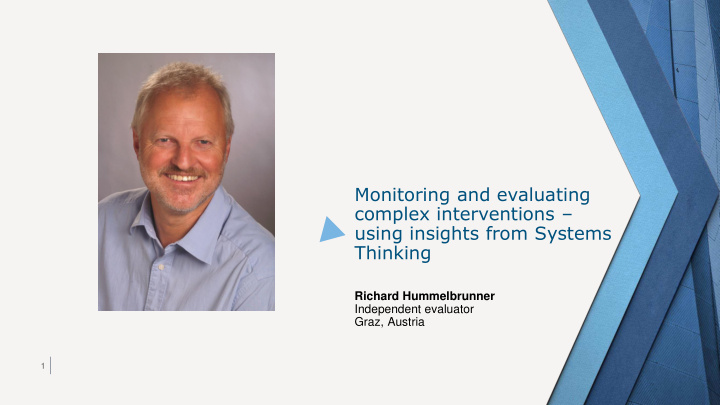



Monitoring and evaluating complex interventions – using insights from Systems Thinking Richard Hummelbrunner Independent evaluator Graz, Austria 1
Challenges of increasing complexity for M&E • Interventions become more complex (= multi-layered / -faceted) › require interaction of various actors (social beings) › influenced by contextual conditions / external factors › need to be shaped / adapted during implementation • Challenges for Monitoring & Evaluation › cope with shifting / diverse realities, more than one logic › inappropriate dealing with complexity can lead to: questionable findings, harm credibility and relevance, bring forth resistance ➢ Replace / complement linear thinking by systems thinking to deal appropriately with complexity, avoid inappropriate simplifications! 2
Practical problems in applying Systems Thinking • No uniform stock of knowledge, no generally agreed definition(s) • Ways to conceptualize realities as systems › as physical entities, real world objects › as mental representations (‘maps’) – not the real world! Boundary SYSTEM CONTEXT Relation Element 2
...more practical problems – and a way forward • Systems and evaluation are methodologically large fields, but › most are only familiar with parts (approaches / methods) › many approaches / methods are geographically bound • Potential risks › use approaches / methods as starting point, not the situation › ‘one - size fits all’ attitude, inappropriate applications ➢ Three core concepts capture essence of Systems Thinking ➢ Methods / techniques can be aligned with these core concepts ➢ Allow evaluators to integrate Systems Thinking in their practice 2
Core Systems Concepts • Interrelationships › dynamic, non-linear aspects: models for insight or prediction › E.g. SNA, Causal Loop Diagrams, (Human) Systems Dynamics • Perspectives › (re)framing a situation (stakeholders, stakes), build consensus › E.g. Soft Systems Methodology, Circular Dialogue • Boundaries › reflect the consequences of boundary choices / selections › not ‘h o lism’, but awareness; reductionist stance › E.g. Critical Systems Heuristics, Dialectic Methods of Inquiry 2
... A Resource Systems Concepts in Action: A Practitioners Toolkit Bob Williams & Richard Hummelbrunner 2011 (Stanford University Press) Guidance and detailed descriptions / examples › For each of the 3 core concepts › For 19 selected methods (plus variations) We advocate: › using questions for choosing methods › multi-methodology, creative combinations ›use of systems methods alongside other ‘traditional’ methods 2
Complexity: Implications for Monitoring • Standardized and static approaches based on predefined indicators are often inappropriate or insufficient, provide information (too) late • Need for more comprehensive, flexible and dynamic approaches › focus on relations of elements (= actions, behaviour) › inform on context / external factors, unintended effects › capture various perspectives, show relevant differences • Monitoring to inform adaptive management › serves to initiate corrective action in due time › early information about likely achievement of effects (‘on track’) › information needs of implementers (= responsible for success) ➢ Periodic up-dates of intervention logic and monitoring activities 2
Example: Causal Link Monitoring Assumptions about Causal Links Behaviour(al changes) Capacities Actions From different perspectives INPUTS / OUTPUTS RESULTS IMPACTS ACTIVITIES Unplannd Unplanned Supporting / hindering Factors External Factors Activities of others Other influences T i m e 2
Systemic Monitoring Approaches: Key Principles • Selection and priority setting (e.g. relevance, uncertainty, divergence) • Flexibility: Areas of observation may change over time • Combination of qualitative and quantitative information • Conscious reflection on deviations / differences in data › do not regard differences a priori as negative! › look for clues (relevant changes, new challenges and patterns) › focus on exceptions, discontinuities, contradictions and puzzles • Monitoring as learning loop(s) during implementation › Up-dated programme theories are more realistic ➢ Other monitoring approaches operate without programme theory (e.g. Most Significant Change Monitoring) 2
Complexity: Implications for (Impact) Evaluation • Limited value of rigorous impact evaluations (e.g. RCTs) › clear, unambiguous causalities are rare, difficult to establish / prove › risk of inappropriately / falsely attributing effects • Select appropriate theory-based approaches, with respect to evaluation questions and programme attributes • Causal inference depends on how programmes work › Necessary: only way to achieve effects – or one of several options › Sufficient: works alone and uniform - or only in combination with other interventions, for specific actors and under certain conditions Differentiate according to degree of complexity ➢ 2
Theory – based impact evaluations: Align approach with nature of situation (domain) Domain Characteristics Causality Simple • high certainty and agreement • clear, predictable and ‘known’ • known right answer controllable • best practice ‘recipes’ Compli- • some uncertainty and some disagreement • neither obvious nor cated • good practices predictable ‘know - able’ • requires analysis, coordination and expert • depends on context knowledge • alternative routes Complex • high uncertainty and high disagreement • only evident in ‘unknow - • every situation is unique retrospect able’ • requires observing relations and (behaviour) • depends on initial patterns conditions 2 Sources: Glouberman and Zimmerman, Kurtz and Snowden, Rogers, Patton
Complexity - aware designs for impact evaluations • Contribution Analysis • Process Tracing • Realist Impact Evaluation • Qualitative Comparative Analysis • Outcome Harvesting 2
THANK YOU! Richard Hummelbrunner Baumgasse 10 8045 Graz, Austria +43 664 2556208 r.hummelbrunner@a1.net 4
Recommend
More recommend